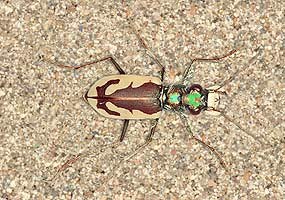
NPS/Phyllis Pineda Bovin Endemic Insects of Great Sand Dunes Endemic species are those that exist at only one location or area on Earth. They tend to be more numerous in habitats that are distinctly different from the surrounding areas. The Great Sand Dunes harbor at least seven endemic species of insects. Many of the insects here are 'sand obligates', meaning that they are adapted uniquely for sandy habitats such as the dunefield. Currently, just over 1,000 different kinds of arthropods (insects and spiders) are known to live at the Great Sand Dunes. However, this may represent only about 25% of the total number of arthropods that may exist here. Great Sand Dunes Tiger Beetle Cicindela theatina The Tiger Beetle is a predatory beetle which is encountered in sparsely vegetated sandy habitats which are beginning to stabilize as successional species like blowout grass (Redfieldia flexuosa) and scurf pea (Psoralea lanceolatum) become established. Both the adults and larvae are predatory; the adults are active foragers on the sand, while the larvae are sedentary ambush predators. Both larvae and adults will prey on a variety of arthropods including ants, other small beetles, and mites crawling on the sand surface. They will even scavenge on dead insects, as long as they are not dried out. Tiger Beetles are about 3/4" (13mm) long and are named for their distinctive coloring. At Great Sand Dunes, they are only observed away from the main areas where people walk. Watch closely, as these beetles run quickly and fly fast over short distances. 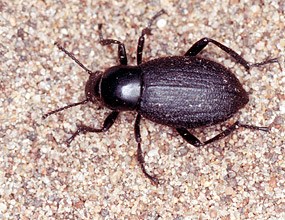
NPS/Phyllis Pineda Bovin Circus Beetle Eleodes hirtipennis Circus beetles are 1/2"- 3/4" (1-2 cm) long. They are scavengers in sandy habitats with sparse vegetation. Look carefully, however; another species of Eleodes lives here which looks similar and is more widespread. 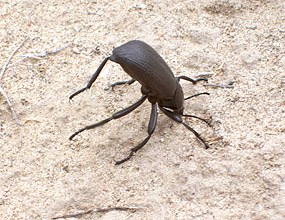
NPS/Patrick Myers The endemic circus beetle's specific name, hirtipennis, means "hairy wings". If you find a beetle that appears to be the endemic one, look carefully at its back. If it is a smaller beetle and there is 'fuzz' on its back, you're observing one of endemic circus beetles. Why do Circus Beetles Stand on Their Heads?
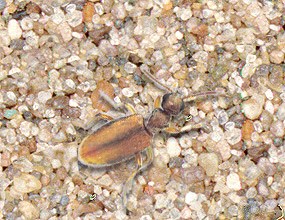
NPS Werner's Ant-like Flower Beetle Amblyderus werneri Triplehorn's Ant-like Flower Beetle Amblyderus triplehorni This light yellowish-brown beetle is truly tiny, about half the size of a pencil tip. It is a scavenger, and prefers the same type of sandy, lightly vegetated habitat that the tiger beetle and the circus beetle do. Although this very small creature is not well understood, its method of foraging is curious. Ant-like flower beetles apparently feed on dead insect parts which have been blown into small depressions in the sand. The beetle allows itself to be blown into the depressions and actively forages on the debris. Triplehorn's Ant-like Flower Beetle, Amblyderus triplehorni, is also a very tiny beetle which looks similar to the Werner's ant-like flower beetle, but is slightly larger. It prefers only the most barren dunes. It is also a scavenger, and its method of foraging is similar to that of Werner's. It is easily observed on the bare dune ridges as one approaches the high dunes. 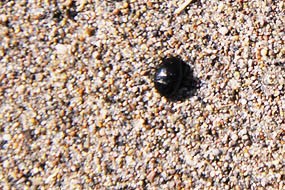
NPS/Patrick Myers Clown Beetle Hypocaccus (undescribed species) Tiny, shining black, and globe-shaped, clown beetles (also known as hister beetles) may be found in grassy areas of the dunes, or even near the tops of the highest dunes. The adults are scavengers, while the larvae (caterpillars) are predatory, probably preying on weevils (Curculionidae), scarab beetles (Scarab-aeidae), and fly larvae that they find feeding on decaying grasses and other non-woody plants. With their round bodies, clown beetles can roll along with the wind to a new location. They may also flip over when held in your hand. 
NPS/Patrick Myers Noctuid Moth Copablepharon (undescribed species) Not much is known about this particular moth. Although it is a noctuid moth, it lacks the rather drab grey-brown appearance of its cousins, the "Miller Moths" or "Cutworm Moths". Rather, this species of noctuid moth is a soft, white color like moonlight. Its wingspan measures about 1.5" (3.5 cm). Adults can be found in the sparsely vegetated and grassy margins of the dunes during the daytime, and will come to lights at night. 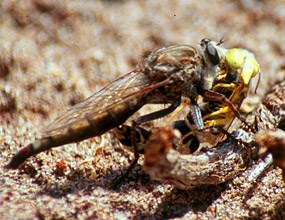
NPS Robber Fly Proctacanthus (undescribed species) This insect has been found in the Great Sand Dunes and surrounding habitat. It is one of the largest insects documented from the area, measuring nearly 1" (2.5 cm) in length. Robber flies do not seem to have a preference for a particular type of sandy habitat; they have been encountered in sand/grass, sand/shrub, and even bare sand environments. Robber flies are often observed foraging on other flying insects (wasps, bees, and flies) during the heat of the day, after all crawling insects have taken cover from the extreme heat of the sand. |
Last updated: May 1, 2025
